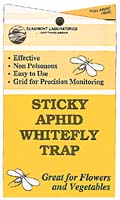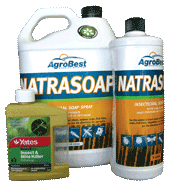| Organic Seeds | Edible Plants | Organic Pest Controls | Books | Tools, Propagation & Fertilisers | Sprouting & Microgreens | Poultry Supplies | Specials & Gift Ideas |

Top

We will send an email to this address*
when is next available
* we will use this email address only for this notification and then we will delete it.
 Home
Home
Green Harvest Organic Gardening Supplies is permanently closed as of 5pm on 1-11-2023.
We will not be taking orders by this website, in person, by phone or email. Our display garden and retail shop are closed forever.
Read more...
Phone:07 54357000
Phone calls will only be responded to sporadically and only in reference to orders placed prior to 2-11-2023. All the useful growing and organic pest management research and resources are available on this website for a while still.
 The adults are small white moth-like flies, 1 mm in length. Eggs are laid on the undersides of leaves and hatch
in 8 days. Both newly hatched 'crawlers' and adults feed by sucking the sap from the underside of the leaf.
They also excrete 'honeydew' which causes problems with black sooty mould. After 4 nymph stages they form a
black pupa, visible as a small speck under the leaves. Most species can complete a full life cycle in 20-30
days, less in summer. Each adult female may lay 200 eggs. Egg laying increases in warm weather. Whiteflies
have no hibernation period and must have a suitable host all year. Severe winters reduce numbers
considerably.
The adults are small white moth-like flies, 1 mm in length. Eggs are laid on the undersides of leaves and hatch
in 8 days. Both newly hatched 'crawlers' and adults feed by sucking the sap from the underside of the leaf.
They also excrete 'honeydew' which causes problems with black sooty mould. After 4 nymph stages they form a
black pupa, visible as a small speck under the leaves. Most species can complete a full life cycle in 20-30
days, less in summer. Each adult female may lay 200 eggs. Egg laying increases in warm weather. Whiteflies
have no hibernation period and must have a suitable host all year. Severe winters reduce numbers
considerably.Suggested Organic Strategies:
- A parasitic wasp Encarsia formosa is commercially available as a biological control.
- Other predators include spiders, ladybird larvae, lacewings, hoverflies and damsel bugs.
- Sticky yellow traps are useful at the beginning of the season.
- Vacuuming in the early morning when whiteflies are cold and slow-moving with a small hand-held battery operated vacuum is useful particularly for the adults before a great deal of egg-laying is done. After vacuuming enclose the section of the machine containing the bag with plastic and put in the freezer for 24 hours.
- Companion plants e.g. nasturtium may help to repel the pest.
Organic Strategies for Whitefly Control © Frances Michaels
Whiteflies suffer from an identity crisis, as they are not flies at all. they resemble tiny, pure white moths but are, in fact, closely related to sap-sucking aphids. Cast-off aphid skins on leaves could be mistaken for whitefly, but whitefly will quickly flutter up and fly away when disturbed, whereas the aphid skins will simply drop off. Just shake the plant to find out which you have!
A Modern Pest
In many ways, whitefly is a modern pest, created by the over-use of pesticides that have killed off its natural enemies. One study has even demonstrated an increased whitefly reproductive capacity when sprayed with certain insecticides!
While there are about 20 species in Australia, the most serious pest is the greenhouse whitefly Trialeurodes vaporariorum that attacks a very wide range of plants including tomatoes and beans. Unfortunately, whiteflies don't go round in ones or twos - they go round in hordes, so a severe attack can have a major impact on a plant.
Whiteflies suck sap from the plant, resulting in a yellow mottling on the surface of the leaf, as well as leaf loss, wilting and stunting. Not only do they feed on plants, but they also produce honeydew, which spoils the plants' appearance, attracts ants and black sooty mould. Whiteflies can also transmit plant viruses.
Adult whiteflies have a 3 mm wingspan and are covered with a white, waxy coating. Each adult female lays about 200 eggs on the underside of the leaves. The eggs hatch in eight days. Newly hatched 'crawlers' or 'nymphs' move around for a few days, but then insert their feeding tube and lose their functional legs. At this stage, they can be confused with scale.
Most species can complete a full life-cycle in 20 to 30 days, less in summer. Whiteflies have no hibernation period and must have a suitable host all year. Severe winters reduce numbers considerably.
Biological Controls
- Natural enemies of whitefly include small birds, spiders, lacewings, hoverflies, ground beetles, mirid bugs and damsel bugs. The adults and larvae of some ladybirds also feed on whiteflies. Habitat, such as a border of perennial plants, needs to be available all year round as a refuge for these predators.
- An important predator and parasitoid of whiteflies is the tiny wasp Encarsia formosa. It is available commercially from Biological Services, PO Box 501, Loxton, SA 5333 Ph 08 85846977. It is most likely to be effective inside glasshouses rather than outdoors, Encarsia wasps kill whitefly nymphs in one of two ways: they lay an egg inside the nymph, providing food for their young, or they kill the nymph outright and feed on it. Once the whitefly nymphs are parasitised they turn black and no longer feed.
Physical and Cultural Controls
If you had clouds of whiteflies on your tomatoes or beans in the previous year, then acting early in the spring is your best bet to control this pest! Useful strategies include:
- Vacuuming in the early morning (when whiteflies are cold and slow moving) can remove many of the adults before they have a chance to lay many eggs. After vacuuming, empty the vacuum bag into a plastic bag and put in the freezer for 24 hours.
- At the beginning of the season, hang sticky yellow traps above the plants to detect an invasion early. Tapping the plants with a stick will cause the whitefly to fly up and onto the traps. Whiteflies are strongly attracted to the colour yellow, so avoid wearing yellow clothing around whiteflies or you may carry them from plant to plant.
- Use a floating row cover such as a Vege Net for early-season protection.
- Handpick older leaves to remove young whitefly stages.
- Avoid using a lot of nitrogen fertilizer, including manures, as succulent growth will increase whitefly populations. You may need to check your phosphorus and magnesium levels, as deficiencies in these are believed to contribute to whitefly infestations.
- Try a high pressure hosing in the early morning, three days in a row.

Least-Toxic Chemical Controls
Whiteflies began showing resistance to synthetic insecticides many years ago, and have since become a major problem in some crops and greenhouses. To control an infestation, use a suitable organic spray as soon as adults are noticed and make sure you spray underneath the leaves. Sprays include:
- Potassium soap sprays such as Natrasoap or Nature's Way Vegie and Herb Spray are a good choice of control for the home gardener; spray every two to three days for two weeks. Soap sprays work by blocking the insect's breathing pores and dissolving its outer covering, resulting in dehydration. They are considered very safe for the environment.
- Eco Oil is certified organic and can be used to control a range of insect pests including whitefly. For best results, use it at the first sign of infestation. Eco Oil has an enhanced formulation which helps to attract beneficial insects into the garden.
- Neem is a botanical insecticide made from extracts of the neem tree. Eco-neem is a registered organic spray that controls a wide range of insects including whitefly. It works in multiple ways with the two main actions being suppression of insect appetite (they starve to death) and restricting growth (unable to moult successfully). It is approved in Australia for use on ornamental plants only but would be particularly useful sprayed on a trap crop of tall, lush grass. Research undertaken in New Zealand on neem's effectiveness for whitefly found that it had a major impact by preventing the 'nymph' stage from developing into an adult; the nymphs tend to disappear from the treated plants.
- Botanical insecticides such as garlic or a hot chilli spray are useful. You can try making these at home yourself but always test the spray on one plant (the one you are least fond of) before spraying the whole garden. Commercial formulations are less likely to burn the leaves.

Suggested Products:
Eco-Neem
Eco-Oil
Exclusion
Natrasoap
Sticky Yellow Traps
 Home
Home
Green Harvest Organic Gardening Supplies is permanently closed as of 5pm on 1-11-2023.
We will not be taking orders by this website, in person, by phone or email. Our display garden and retail shop are closed forever.
Read more...
Phone:07 54357000
Phone calls will only be responded to sporadically and only in reference to orders placed prior to 2-11-2023. All the useful growing and organic pest management research and resources are available on this website for a while still.
No liability will be accepted by Green Harvest, its owners or employees as to the accuracy of any information. No responsibility will be taken for damage to property or persons due to information given about a product or technique. No responsibility will be taken for the loss of a crop or income due to information given about a product or technique.
 Shopping here is private and secure.
Shopping here is private and secure.
Copyright © 2001 - 2024 Green Harvest Organic Gardening Supplies
No part of this website may be reproduced without permission of the owner